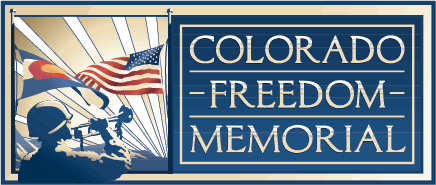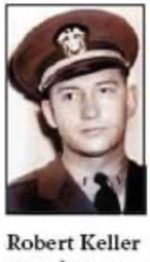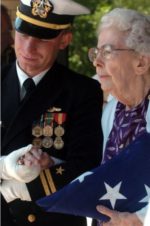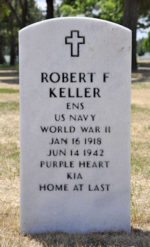Rite for WWII reservist brings solace to sister - 2006
The goodbyes came nearly a lifetime apart.
Eleanor Keller sat quietly at the side of her brother’s casket Wednesday at Fort Logan National Cemetery, eyes steady on the flag-draped coffin, as if she didn’t want Navy Ensign Robert Keller to leave her sight again.
Not after what happened before.
The first goodbye came 64 years earlier, when Robert Keller was 24 and shipped out as a Naval reservist during World War II. The Colorado native died a few months later, after the plane in which he was flying was shot down and crashed into a volcano as part of a long-forgotten battle with Japanese forces on Kiska Island, a spot in the Aleutian Island chain that stretches from mainland Alaska through the Pacific Ocean. The bodies of Robert Keller and six other airmen were discovered about a year afterward and buried at the site.
Nearly 60 years later, a biologist discovered the burial site amid harsh terrain. That led to an eventual military recovery mission and an identification of the men’s remains. Which led to Wednesday’s long- awaited final goodbye, the one Eleanor never dreamed of saying two generations ago. “I thought about him every day at first,” Keller’s 86-year-old sister said. “It’s just wonderful that I got him back.”
A horse-drawn hearse lurched forward as Robert Keller’s coffin was placed inside. The pop of his wooden casket against metallic rollers rang out. A few dozen sailors saluted. Chaplain Jim Chapman leaned in to Keller’s nephew, John Robert Keller. “This is a good day, a good day,” the chaplain said. “Don’t be sad.”
The men and women lined up. The carriage driver asked if everyone was ready. Chapman gave a thumbs up. Then they walked. A picture-perfect day.
Keller was a reporter for the Wichita Eagle when he signed up for the Naval Reserve in 1941. Perhaps this was an end befitting a former professional journalist- a story once without an ending, suddenly made whole by a stroke of luck or maybe fate.
Whatever it was, Keller’s sister wished their parents could have seen the day her brother was buried: the azure sky and the doves, the bagpiper, the men and women in uniform. Earl Clark approached Eleanor as she stood near her brother’s coffin. The retired lieutenant colonel from the then-87th Mountain Infantry Regiment touched her hand. “My unit was the first to find him,” Clark said. “I wasn’t there. The burial team came later.” Eleanor raised her head. “I just wanted to have the opportunity to tell you that I was part of that scene.” “How was the weather?” Eleanor asked, wanting to know more about her brother’s former surroundings. “It was terrible,” Clark said. The two smiled. Clark looked at the folded flag that Eleanor cradled in her arms. “This,” he said, patting the flag, “is a treasure.”
Finally, journey’s end. After everyone had gone, Keller’s casket was moved to Section 25, Grave 827. A Fort Logan crew lowered it into the ground, but not before a worker spotted a laminated tag attached to the coffin. “His date of death is June 1942,” the man said. “I wasn’t even born yet.” “Where’d they find him at?” another asked. “Alaska.” “Wow, what was he doing there?”
Keller’s marble gravestone was in a nearby vehicle, etched with dates, his rank and a note that he was killed in action. And just below that, a message his sister never thought she would see: “Home at last.”
By Robert Sanchez, Denver Post
Robert F. Keller (DE-419)
(DE-419: displacement 1,745 (full load); length 306'0"; beam 36'7"; draft 13'4"; speed 24 knots; complement 222; armament 2 5", 4 40mm., 10 20mm., 2 depth charge tracks, 8 depth charge projectors, 1 depth charge projector (hedgehog-type), 3 21" torpedo tubes; class John C. Butler)
Robert Franklin Keller, born in Denver, Colo., 16 January 1918, and eventually moved to Kansas where he worked for the Wichita Eagle News. He enlisted in the U.S. Naval Reserve as seaman second class in Kansas City, Kans., 14 February 1941, and was appointed an Aviation Cadet 15 May 1941. He was commissioned ensign, USNR, 10 October 1941. Following training in Kansas, Florida, Texas, and California, he reported 15 February 1942 to Patrol Squadron 43. He earned the Air Medal as second pilot of a patrol plane in action against enemy Japanese forces during the Aleutian Islands Campaign 10 June to 20 June 1942. "Braving severe Alaskan weather and with a low ceiling forcing his plane to fly through clouds to carry out its attack mission against Japanese ships in Kiska Harbor, Ensign Keller skillfully assisted in determined dive-bombing and strafing attacks. Pulling out in the clear at a very low altitude, his plane was subjected to withering antiaircraft fire from enemy ship and shore batteries and pierced by shrapnel and lighter caliber projectiles" on 14 June 1942, and failed to return from the mission.
The Robert F. Keller (DE 419) was laid down by Brown Ship Building Co., Houston, Tex., 12 January 1944; launched 19 February 1944; sponsored by Mrs. Peter S. Keller; and commissioned 17 June 1944, Lt. Comdr. R. J. Toner, USNR, in command.
Following shakedown off Bermuda, Robert F. Keller escorted Currituck (AV-7) to the Canal Zone, then transited the canal 7 September 1944. She picked up a convoy of four Pearl Harbor bound merchantmen at San Francisco and escorted them safely to their destination. Arriving on 1 October, [ Robert F.] Keller joined Escort Division 72, assigned to screen carrier Coral Sea (CVE-57). With the 3d Fleet, the group sailed to the Western Caroline’s arriving 1 November. This became [ Robert F.] Keller's advance base for operations until February 1945. During this time her task group, designated 30.7, conducted antisubmarine sweeps as a hunter-killer group in the Philippine Sea and adjacent waters. On 22 December 1944 [ Robert F.] Keller rescued four survivors of capsized destroyer Hull (DD-350), victim of a typhoon.
On 28 January 1945 all ships of TG 30.7 were assigned to the U.S. 5th Fleet and proceeded on 2 February to cover a group of transports in their voyage from Eniwetok to Saipan. At this newly annexed Pacific island, [ Robert F.] Keller was attached to Air Support Unit 2 and was with that division as it participated in the Iwo Jima campaign of February 1945. While acting as carrier screen, on the night of 21 February, her crew witnessed the sinking of the escort carrier Bismarck Sea (CVE-95)] during a kamikaze attack. She remained in the Iwo area until 7 March and then retired to Leyte Island in the Philippines for upkeep and repair in preparation for the Okinawa operation.
[ Robert F.] Keller was ready for the operation by 21 March 1945 and proceeded to Okinawa, destroying three floating mines enroute. Her duties were identical to those she had known in the Iwo campaign, acting as air defense and antisubmarine screen for the carriers involved in covering the invasion from the air. The ship left the area on 27 April escorting the carrier Anzio (ex- Coral Sea) (CVE-57) to Ulithi. She was back in the war on 10 May escorting the cruiser San Francisco (CA-38) to the Okinawa battle-line and then guarded the convoy lanes around the beleaguered island fortress. She returned to Leyte for availability 17 June.
Task Group 30.6 set out again on 6 July on what was to be [ Robert F.] Keller-s last combat operation of the war, antisubmarine sweeps east of Tokyo. Ten days later [ Robert F.] Keller assisted in a kill when Lawrence C. Taylor (DE-415) caught Japanese submarine I-13 on the surface and raked her with gunfire until she sank. When the end of hostilities was announced, [ Robert F.] Keller proceeded to Guam.
After escorting transports loaded with occupation troops to Jinsen, Korea, on 8 September, [ Robert F.] Keller returned to Okinawa on 22 September. She remained in the Far East for the rest of the year, calling at several Chinese ports.
Robert F. Keller decommissioned 24 April 1946 at San Diego. In September 1946 she was placed "in service" and assigned to the 13th Naval District at Puget Sound, Wash., to lend her assistance in the Navy's Reserve training program. In January 1950, she sailed to the east coast via the Panama Canal and was placed "in commission in reserve" on 31 March 1950, assigned as Naval Reserve Training Ship at Washington, D.C., under Commandant, Potomac River Naval Command. On 18 November 1950, she was again placed on "active status in commission" and trained reserves while maintaining war readiness. Through 1955 she made 39 cruises and assisted in the training of over 3,500 reserve officers and enlisted men and visited most major ports in eastern Canada, the West Indies, and the United States. She continued this duty until 1959, sometimes crossing the Atlantic to visit European ports.
On 21 September 1959 Robert F. Keller decommissioned and was placed "in service" assigned to Naval Reserve training in Baltimore under the Commandant, 5th Naval District. She recommissioned 2 October 1961 incident to the Berlin Crisis and was manned by reserves, steaming in the Atlantic and Caribbean during the rest of the year. She again decommissioned and was placed "in service" as a Naval Reserve training ship of the 5th Naval District, 1 August 1962. She was placed out of commission in reserve at Philadelphia in January 1965, where she remained until 1972. After survey, in the spring of 1972, Robert F. Keller was found to be unfit for further service and was stricken from the Navy list 1 July 1972.




